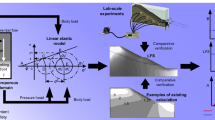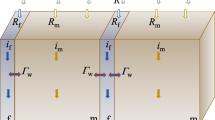Abstract
Landslide-prone slopes in earthquake-affected areas commonly feature heterogeneity and high permeability due to the presence of cracks and fissures that were caused by ground shaking. Landslide reactivation in heterogeneous slope may be affected by preferential flow that was commonly occurred under heavy rainfall. Current hydro-mechanical models that are based on a single-permeability model consider soil as a homogeneous continuum, which, however, cannot explicitly represent the hydraulic properties of heterogeneous soil. The present study adopted a dual-permeability model, using two Darcy-Richards equations to simulate the infiltration processes in both matrix and preferential flow domains. The hydrological results were integrated with an infinite slope stability approach, attempting to investigate the hydro-mechanical behavior. A coarse-textured unstable slope in an earthquake-affected area was chosen for conducting artificial rainfall experiment, and in the experiment slope, failure was triggered several times under heavy rainfall. The simulated hydro-mechanical results of both single- and dual-permeability model were compared with the measurements, including soil moisture content, pore water pressure, and slope stability conditions. Under high-intensity rainfall, the measured soil moisture and pore water pressure at 1-m depth showed faster hydrological response than its simulations, which can be regarded as a typical evidence of preferential flow. We found the dual-permeability model substantially improved the quantification of hydro-mechanical processes. Such improvement could assist in obtaining more reliable landslide-triggering predication. In the light of the implementation of a dual-permeability model for slope stability analysis, a more flexible and robust early warning system for shallow landslides hazard in coarse-textured slopes could be provided.











Similar content being viewed by others
References
Baum RL, Savage WZ, Godt JW (2008) TRIGRS- a Fortran program for transient rainfall infiltration and grid-based regional slope-stability analysis, version 2. 0. U. S. In: Geological survey
Baum RL, Godt JW, Savage WZ (2010) Estimating the timing and location of shallow rainfall-induced landslides using a model for transient, unsaturated infiltration. J Geophys Res Earth Surf 115:F03013. https://doi.org/10.1029/2009jf001321
Beven K, Germann P (2013) Macropores and water flow in soils revisited. Water Resour Res 49:3071–3092. https://doi.org/10.1002/wrcr.20156
Cohen D, Lehmann P, Or D (2009) Fiber bundle model for multiscale modeling of hydromechanical triggering of shallow landslides. Water Resour Res 45:W10436. https://doi.org/10.1029/2009WR007889
Cui P, Zhu Y-Y, Han Y-S, Chen X-Q, Zhuang J-Q (2009) The 12 May Wenchuan earthquake-induced landslide lakes: distribution and preliminary risk evaluation. Landslides 6:209–223. https://doi.org/10.1007/s10346-009-0160-9
Durner W (1994) Hydraulic conductivity estimation for soils with heterogeneous pore structure. Water Resour Res 30:211–223. https://doi.org/10.1029/93WR02676
Dusek J, Gerke HH, Vogel T (2008) Surface boundary conditions in two-dimensional dual-permeability modeling of tile drain bromide leaching. Vadose Zone J 7:1287–1301. https://doi.org/10.2136/vzj2007.0175
Gerke HH, van Genuchten M (1993a) A dual-porosity model for simulating the preferential movement of water and solutes in structured porous media. Water Resour Res 29:305–319. https://doi.org/10.1029/92WR02339
Gerke HH, van Genuchten M (1993b) Evaluation of a first-order water transfer term for variably saturated dual-porosity flow models. Water Resour Res 29:1225–1238. https://doi.org/10.1029/92wr02467
Ghestem M, Sidle RC, Stokes A (2011) The influence of plant root systems on subsurface flow: implications for slope stability. BioScience 61:869–879. https://doi.org/10.1525/bio.2011.61.11.6
Greco R (2002) Preferential flow in macroporous swelling soil with internal catchment: model development and applications. J Hydrol 269:150–168. https://doi.org/10.1016/S0022-1694(02)00215-9
Greco R, Comegna L, Damiano E, Guida A, Olivares L, Picarelli L (2013) Hydrological modelling of a slope covered with shallow pyroclastic deposits from field monitoring data. Hydrol Earth Syst Sci 17:4001–4013. https://doi.org/10.5194/hess-17-4001-2013
Griffiths DV, Lane PA (1999) Slope stability analysis by finite elements. Geotechnique 49:387–403. https://doi.org/10.1680/geot.1999.49.3.387
Griffiths DV, Lu N (2005) Unsaturated slope stability analysis with steady infiltration or evaporation using elasto-plastic finite elements. Int J Numer Anal Methods Geomech 29:249–267. https://doi.org/10.1002/nag.413
Guzzetti F, Peruccacci S, Rossi M, Stark C (2008) The rainfall intensity–duration control of shallow landslides and debris flows: an update. Landslides 5:3–17. https://doi.org/10.1007/s10346-007-0112-1
Hencher SR (2010) Preferential flow paths through soil and rock and their association with landslides. Hydrol Process 24:1610–1630. https://doi.org/10.1002/hyp.7721
Ho J-Y, Lee KT (2017) Performance evaluation of a physically based model for shallow landslide prediction. Landslides 14:961–980. https://doi.org/10.1007/s10346-016-0762-y
Huang R, Pei X, Fan X et al (2012) The characteristics and failure mechanism of the largest landslide triggered by the Wenchuan earthquake, May 12, 2008, China. Landslides 9:131–142. https://doi.org/10.1007/s10346-011-0276-6
Iverson RM (2000) Landslide triggering by rain infiltration. Water Resour Res 36:1897–1910. https://doi.org/10.1029/2000WR900090
Keefer DK, Larsen MC (2007) Assessing Landslide Hazards. Science 316:1136–1138. https://doi.org/10.1126/science.1143308
Krzeminska DM, Bogaard TA, van Asch TWJ, van Beek LPH (2012) A conceptual model of the hydrological influence of fissures on landslide activity. Hydrol Earth Syst Sci 16:1561–1576. https://doi.org/10.5194/hess-16-1561-2012
Krzeminska DM, Bogaard TA, Malet JP, van Beek LPH (2013) A model of hydrological and mechanical feedbacks of preferential fissure flow in a slow-moving landslide. Hydrol Earth Syst Sci 17:947–959. https://doi.org/10.5194/hess-17-947-2013
Kukemilks K, Wagner J-F, Saks T, Brunner P (2017) Conceptualization of preferential flow for hillslope stability assessment. Hydrogeol J. https://doi.org/10.1007/s10040-017-1667-0
Lanni C, McDonnell J, Hopp L, Rigon R (2013) Simulated effect of soil depth and bedrock topography on near-surface hydrologic response and slope stability. Earth Surf Process Landf 38:146–159. https://doi.org/10.1002/esp.3267
Larsbo M, Jarvis N (2003) MACRO 5.0: a model of water flow and solute transport in macroporous soil: technical description. Department of Soil Sciences, Swedish University of Agricultural Sciences Uppsala
Lu N, Godt J (2008) Infinite slope stability under steady unsaturated seepage conditions. Water Resour Res 44:W11404. https://doi.org/10.1029/2008WR006976
Lu N, Godt JW, Wu DT (2010) A closed-form equation for effective stress in unsaturated soil. Water Resour Res 46:W05515. https://doi.org/10.1029/2009WR008646
Lu N, Şener-Kaya B, Wayllace A, Godt JW (2012) Analysis of rainfall-induced slope instability using a field of local factor of safety. Water Resour Res 48:W09524. https://doi.org/10.1029/2012wr011830
Matsushi Y, Matsukura Y (2007) Rainfall thresholds for shallow landsliding derived from pressure-head monitoring: cases with permeable and impermeable bedrocks in Boso Peninsula, Japan. Earth Surf Process Landf 32:1308–1322. https://doi.org/10.1002/esp.1491
Milledge DG, Griffiths DV, Lane SN, Warburton J (2012) Limits on the validity of infinite length assumptions for modelling shallow landslides. Earth Surf Process Landf 37:1158–1166. https://doi.org/10.1002/esp.3235
Ni JJ, Leung AK, Ng CWW, Shao W (2017) Modelling hydro-mechanical reinforcements of plants to slope stability. Comput Geotech. https://doi.org/10.1016/j.compgeo.2017.09.001
Nimmo JR (2012) Preferential flow occurs in unsaturated conditions. Hydrol Process 26:786–789. https://doi.org/10.1002/hyp.8380
Pierson T (1983) Soil pipes and slope stability. Q J Eng Geol Hydrogeol 16:1–11. https://doi.org/10.1144/GSL.QJEG.1983.016.01.01
Pirone M, Papa R, Nicotera MV, Urciuoli G (2015) In situ monitoring of the groundwater field in an unsaturated pyroclastic slope for slope stability evaluation. Landslides 12:259–276. https://doi.org/10.1007/s10346-014-0483-z
Ponziani F, Pandolfo C, Stelluti M, Berni N, Brocca L, Moramarco T (2012) Assessment of rainfall thresholds and soil moisture modeling for operational hydrogeological risk prevention in the Umbria region (central Italy). Landslides 9(2):229–237. https://doi.org/10.1007/s10346-011-0287-3
Postance B, Hillier J, Dijkstra T, Dixon N (2017) Comparing threshold definition techniques for rainfall-induced landslides: a national assessment using radar rainfall. Earth Surf Process Landf 43:553–561. https://doi.org/10.1002/esp.4202
Samia J, Temme A, Bregt A, Wallinga J, Guzzetti F, Ardizzone F, Rossi M (2017) Do landslides follow landslides? Insights in path dependency from a multi-temporal landslide inventory. Landslides 14:547–558. https://doi.org/10.1007/s10346-016-0739-x
Shao W, Bogaard TA, Bakker M, Greco R (2015) Quantification of the influence of preferential flow on slope stability using a numerical modelling approach. Hydrol Earth Syst Sci 19:2197–2212. https://doi.org/10.5194/hess-19-2197-2015
Shao W, Bogaard T, Bakker M, Berti M (2016) The influence of preferential flow on pressure propagation and landslide triggering of the Rocca Pitigliana landslide. J Hydrol. https://doi.org/10.1016/j.jhydrol.2016.10.015
Shao W, Ni J, Leung AK, Su Y, Ng CWW (2017) Analysis of plant root–induced preferential flow and pore-water pressure variation by a dual-permeability model. Can Geotech J 54:1537–1552. https://doi.org/10.1139/cgj-2016-0629
Sidle RC, Bogaard TA (2016) Dynamic earth system and ecological controls of rainfall-initiated landslides. Earth Sci Rev 8(159):275–291. https://doi.org/10.1016/j.earscirev.2016.05.013
Sidle RC, Ochiai H (2013) Landslides: processes, prediction, and land use. American Geophysical Union
Simoni S, Zanotti F, Bertoldi G, Rigon R (2008) Modelling the probability of occurrence of shallow landslides and channelized debris flows using GEOtop-FS. Hydrol Process 22:532–545. https://doi.org/10.1002/hyp.6886
Talebi A, Uijlenhoet R, Troch PA (2008) A low-dimensional physically based model of hydrologic control of shallow landsliding on complex hillslopes. Earth Surf Process Landf 33:1964–1976. https://doi.org/10.1002/esp.1648
Uchida T, Kosugi KI, Mizuyama T (2001) Effects of pipeflow on hydrological process and its relation to landslide: a review of pipeflow studies in forested headwater catchments. Hydrol Process 15:2151–2174. https://doi.org/10.1002/hyp.281
Uchida T, Asano Y, Mizuyama T, McDonnell JJ (2004) Role of upslope soil pore pressure on lateral subsurface storm flow dynamics. Water Resour Res 40:W12401. https://doi.org/10.1029/2003WR002139
Van Asch TWJ, Buma J, Van Beek LPH (1999) A view on some hydrological triggering systems in landslides. Geomorphology 30:25–32. https://doi.org/10.1016/S0169-555X(99)00042-2
van Dam JC, Feddes RA (2000) Numerical simulation of infiltration, evaporation and shallow groundwater levels with the Richards equation. J Hydrol 233:72–85. https://doi.org/10.1016/S0022-1694(00)00227-4
Van Genuchten MT (1980) A closed-form equation for predicting the hydraulic conductivity of unsaturated soils. Soil Sci Soc Am J 44:892–898
Vogel T, Gerke HH, Zhang R, Van Genuchten MT (2000) Modeling flow and transport in a two-dimensional dual-permeability system with spatially variable hydraulic properties. J Hydrol 238:78–89. https://doi.org/10.1016/S0022-1694(00)00327-9
Wilkinson PL, Anderson MG, Lloyd DM (2002) An integrated hydrological model for rain-induced landslide prediction. Earth Surf Process Landf 27:1285–1297. https://doi.org/10.1002/esp.409
Yang Z, Qiao J, Uchimura T, Wang L, Lei X, Huang D (2017) Unsaturated hydro-mechanical behaviour of rainfall-induced mass remobilization in post-earthquake landslides. Eng Geol 222:102–110. https://doi.org/10.1016/j.enggeo.2017.04.001
Yang Z, Cai H, Shao W, Huang D, Uchimura T, Lei X, Tian H, Qiao J (2018) Clarifying the hydrological mechanisms and thresholds for rainfall-induced landslide: in situ monitoring of big data to unsaturated slope stability analysis. Bull Eng Geol Environ 5:1–12. https://doi.org/10.1007/s10064-018-1295-5
Zhang LM, Zhang S, Huang RQ (2014) Multi-hazard scenarios and consequences in Beichuan, China: the first five years after the 2008 Wenchuan earthquake. Eng Geol 180:4–20. https://doi.org/10.1016/j.enggeo.2014.03.020
Zhou C, Shao W, van Westen CJ (2014) Comparing two methods to estimate lateral force acting on stabilizing piles for a landslide in the Three Gorges Reservoir, China. Eng Geol 173:41–53. https://doi.org/10.1016/j.enggeo.2014.02.004
Zhuang J, Peng J, Wang G, Iqbal J, Wang Y, Li W, Xu Q, Zhu X (2017) Prediction of rainfall-induced shallow landslides in the Loess Plateau, Yan’an, China, using the TRIGRS model. Earth Surf Process Landf 42:915–927. https://doi.org/10.1002/esp.4050
Zieher T, Schneider-Muntau B, Mergili M (2017) Are real-world shallow landslides reproducible by physically-based models? Four test cases in the Laternser valley, Vorarlberg (Austria). Landslides. https://doi.org/10.1007/s10346-017-0840-9
Funding
The field experience was financially supported by the National Natural Science Foundation of China (Grant Nos. 41771021, 41471012, 41807286), the Hundred Young Talents Program of IMHE (Grant No.SDSQB-2016-01), and the Science and Technology Service Network Initiative of Chinese Academy of Science (Grant No.KFJ-EW-STS-094, KFJ-STS-ZDTP-015). The first author was financially supported by the China Postdoctoral Science Foundation (Grant Nos. 2017M621783, 2018T110527), the International Postdoctoral Exchange Fellowship Program by China Postdoctoral Council (Year 2017), and the Startup Foundation for Introducing Talent of NUIST (No.2017r045).,
Author information
Authors and Affiliations
Corresponding author
Rights and permissions
About this article
Cite this article
Shao, W., Yang, Z., Ni, J. et al. Comparison of single- and dual-permeability models in simulating the unsaturated hydro-mechanical behavior in a rainfall-triggered landslide. Landslides 15, 2449–2464 (2018). https://doi.org/10.1007/s10346-018-1059-0
Received:
Accepted:
Published:
Issue Date:
DOI: https://doi.org/10.1007/s10346-018-1059-0




